The American Ballet Theater celebrated LGBTQ History Month by hosting its first-ever Pride Nights on October 27 and October 30. The inaugural events featured a lobby photo exhibition by queer photographer Quil Lemons, and the performance of 4 ballets: Alexei Ratmansky’s Bernstein in a Bubble, Christopher Rudd’s Touché, Clark Tippet’s Some Assembly Required, and Darrell Grand Moultrie’s Indestructible Light. Each Pride Night featured a special appearance by drag artist Lypsinka, and concluded with a post-performance panel discussion featuring the creators of Touché. The post-performance panel discussions were moderated by trans actress and former ballet dancer, Tommy Dorfman.
GLAAD sat down with Christopher Rudd, choreographer of Touché, and Connor Holloway (they/them), a dancer and social media manager for the American Ballet Theater; collectively, their efforts helped bring Pride Nights to fruition.
Rudd and Holloway spoke about what ABT’s Pride Nights programming and the performance of Touché symbolized for the ballet community and the LGBTQ community at large. They also shared their hopes for the future of Pride Nights programming and creating a lasting, inclusive ballet culture.
Touché is an all-male pas de deux. A pas de deux is a form of ballet in which two dancers, typically male and female, perform ballet steps together. In our discussion, Rudd, who created the dance, shared that though he wanted to speak to gay romance through dance, before Touché he hadn’t been given the opportunity. That changed in October 2019 when he was offered a commission to create a 12-minute pas de deux. Rudd found inspiration for his pas de deux during a rehearsal in which he saw a male dancer move across the floor while wearing the Black Swan tutu and shoes typically designated for female dancers. The power and queerness that Rudd felt from this experience made him envision a work that would later become the first explicitly queer, non-platonic, and unquestionably romantic ballet for the ABT. Describing classical ballet as “an art without language”, Rudd spoke to the talents of the dancers who, “from day one”, were committed to creating an authentic performance, one in which disbelief from the audience could be suspended and a powerful visual exhibition of homoeroticism could be presented.
Touché, in addition to representing queer love through classical ballet, also showcased an alternate, softer form of masculinity not typically seen on the stage. Emphasizing balanced power dynamics, this soft masculinity deters from hegemonic, at times toxic masculinity to show new depths of emotion and masculine representation. Alternate forms of masculinity were also celebrated through Pride Nights’ featuring of Quil Lemons’ photography. Quil is a Black, queer photographer whose work grapples with subjects of race, masculinity, beauty, and queerness. His work shows beautiful and fantastical scenarios, which, according to Pride Nights producer Connor Holloway, showed a “different side of culture” not normally seen in large, mainstream theaters like those at Lincoln Center.

For Holloway, the featuring of alternate masculinities by a Black, queer photographer was a “very intentional” aspect of creating a diverse and inclusive program. The program, starting with Quil Lemon’s photo exhibition, also featured an appearance by drag artist Lypsinka, whose alter ego John Epperson has served as a pianist for the American Ballet Theater over the last 43 years. Though John has been a part of the American Ballet Theater for almost 50 years, it was the first time he could perform his drag identity Lypsinka on the ABT stage. With the inclusion of a Q&A moderated by actress and former ballet dancer Tommy Dorfman, Holloway ensured that, from start to finish, diverse artists of all kinds would be given a well-deserved spotlight in the Pride Nights program.


To Holloway, the success of the Pride Nights programming showed that “there [was] a real hunger for this type of representation”. The increase and diversity of representation in the programming resulted in an extremely diverse audience; Lypsinka’s fanbase from the drag community came out and Ian Isaiah, a Black and self-described “genderless” musician also attended Pride Nights.
In terms of what this means for the future of ballet, Holloway supports Rudd’s belief that continued diversity in storytelling, performers, and featured artists “ensur[es] the longevity of the art form”. Rudd also believes that uplifting the stories of marginalized communities through works like Touché signals an “evolution of classical ballet” and that sharing stories that “reflect the times we live in” will be what enables the art form to survive.













